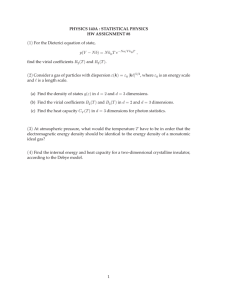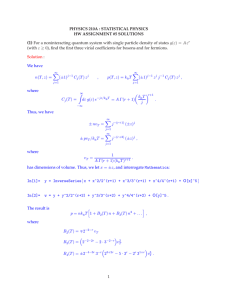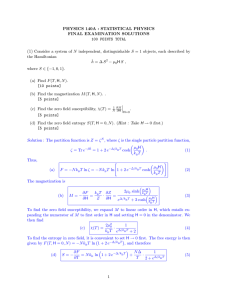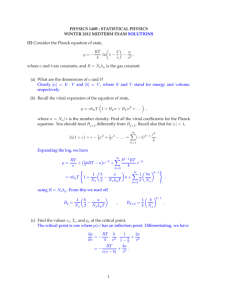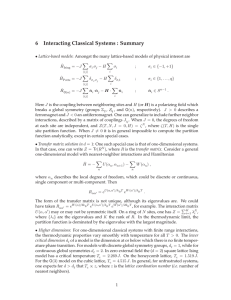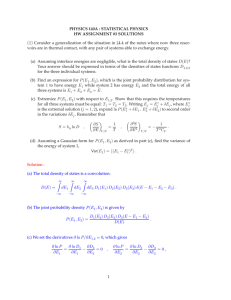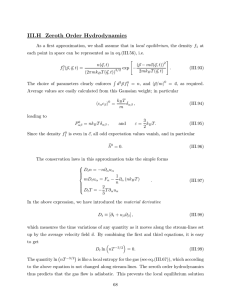(1)
advertisement
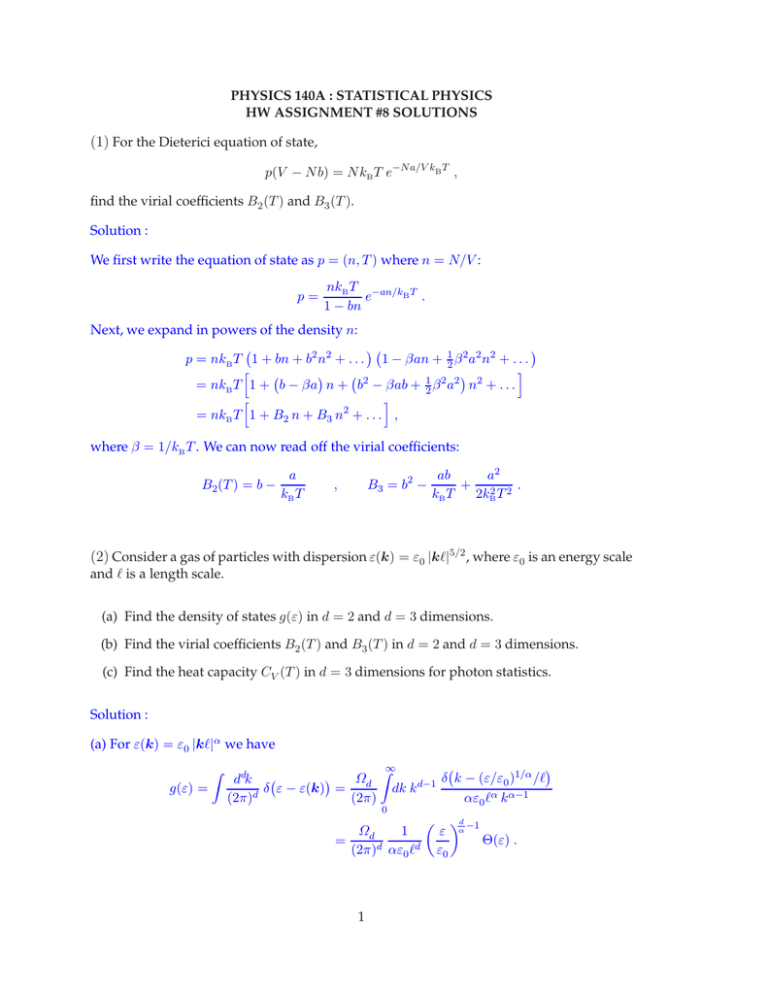
PHYSICS 140A : STATISTICAL PHYSICS HW ASSIGNMENT #8 SOLUTIONS (1) For the Dieterici equation of state, p(V − N b) = N kB T e−N a/V kB T , find the virial coefficients B2 (T ) and B3 (T ). Solution : We first write the equation of state as p = (n, T ) where n = N/V : p= nkB T −an/k T B e . 1 − bn Next, we expand in powers of the density n: p = nkB T 1 + bn + b2 n2 + . . . 1 − βan + 12 β 2 a2 n2 + . . . h i = nkB T 1 + b − βa n + b2 − βab + 12 β 2 a2 n2 + . . . h i = nkB T 1 + B2 n + B3 n2 + . . . , where β = 1/kB T . We can now read off the virial coefficients: B2 (T ) = b − a kB T B3 = b2 − , ab a2 + 2 2 . kB T 2kB T (2) Consider a gas of particles with dispersion ε(k) = ε0 |kℓ|5/2 , where ε0 is an energy scale and ℓ is a length scale. (a) Find the density of states g(ε) in d = 2 and d = 3 dimensions. (b) Find the virial coefficients B2 (T ) and B3 (T ) in d = 2 and d = 3 dimensions. (c) Find the heat capacity CV (T ) in d = 3 dimensions for photon statistics. Solution : (a) For ε(k) = ε0 |kℓ|α we have g(ε) = Z Ω ddk δ ε − ε(k) = d (2π)d (2π) Z∞ 1/α /ℓ d−1 δ k − (ε/ε0 ) dk k αε0 ℓα kα−1 0 Ωd 1 = d (2π) αε0 ℓd 1 ε ε0 d −1 α Θ(ε) . Thus, for α = 52 , 1 gd=2 (ε) = 5πε0 ℓ2 ε ε0 −1/5 Θ(ε) 1 gd=3 (ε) = 5πε0 ℓ3 , ε ε0 1/5 Θ(ε) . (b) We must compute the coefficients Z∞ αd −1 Z∞ Ωd ε 1 −jε/kB T e−jε/kB T = dε Cj = dε g(ε) e (2π)d αε0 ℓd ε0 0 −∞ = Ωd Γ(d/α) 1 (2π)d αℓd kB T jε0 d/α ≡ j −d/α λ−d T , where 2πℓ λT ≡ 1/d Ωd Γ αd /α Then ε0 kB T 1/α . d C2 +1 − α λdT = ∓2 B2 (T ) = ∓ 2 C12 d d C22 2 C3 −α −α 2 − 3 ·3 B3 (T ) = 4 − 3 = 4 λ2d T . C1 C1 We have α = 25 , so d α = 4 5 for d = 2 and 6 5 for d = 3. (c) For photon statistics, the energy is Z∞ E(T, V ) = V dε g(ε) ε 1 eε/kB T V Ωd ε0 = Γ (2πℓ)d α −1 d α −∞ Thus, V Ωd kB ∂E = Γ CV = ∂T (2πℓ)d α d α +2 ζ d α +1 ζ d α d kB T α +1 +1 ε0 d kB T α . +1 ε0 (3) At atmospheric pressure, what would the temperature T have to be in order that the electromagnetic energy density should be identical to the energy density of a monatomic ideal gas? Solution : The pressure is p = 1.0 atm ≃ 105 Pa. We set E = V 3 2 p= 2π 2 (kB T )4 , 30 (~c)3 2 and solve for T : # " 3 1/4 1 J m 45 T = · · (105 Pa) · 1970 eV Å · 1.602 × 10−19 · 10−10 1.38 × 10−23 J/K 2π 2 eV Å = 1.19 × 105 K . (4) Find the internal energy and heat capacity for a two-dimensional crystalline insulator, according to the Debye model. Solution : We have " # Z∞ ~ω Ω(T, V ) = N kB T dω g(ω) ln 2 sinh . 2kB T 0 The internal energy is given by ∂(βΩ) = E(T, V ) = ∂β 1 2 Z∞ ~ω N dω g(ω) ~ω ctnh . 2kB T 0 In the three-dimensional Debye model, the phonon density of states per unit cell is g(ω) = 9ω 2 Θ(ωD − ω) , ωD3 where ωD is the Debye frequency. Thus, 9N ~ E(T ) = 2ωD3 ZωD ~ω 3 dω ω ctnh 2kB T 0 72N = (k T )4 (~ωD )3 B ~ωD 2k T B Z ds s3 ctnh (s) . 0 In d = 2 dimensions, we must replace the phonon density of states with g(ω) = 4ω Θ(ωD − ω) . ωD2 3 This guarantees that the integrated phonon density of states per unit cell is 2, which is the number of acoustic phonon modes in two dimensions. We then have ZωD ~ω 2~ 2 E(T ) = 2 N dω ω ctnh ωD 2kB T 0 16N (k T )3 = (~ωD )2 B ~ωD 2k T B Z ds s2 ctnh (s) . 0 The heat capacity is ∂E N ~2 CV = = ∂T kB T 2 ωD2 = 16N kB kB T ~ωD ZωD ~ω dω ω 3 csch 2 2kB T 0 ~ωD 2k T B 2 Z ds s2 csch 2 (s) . 0 One can check that limT →∞ CV (T ) = 2N kB , which is the appropriate Dulong-Petit limit. 4
